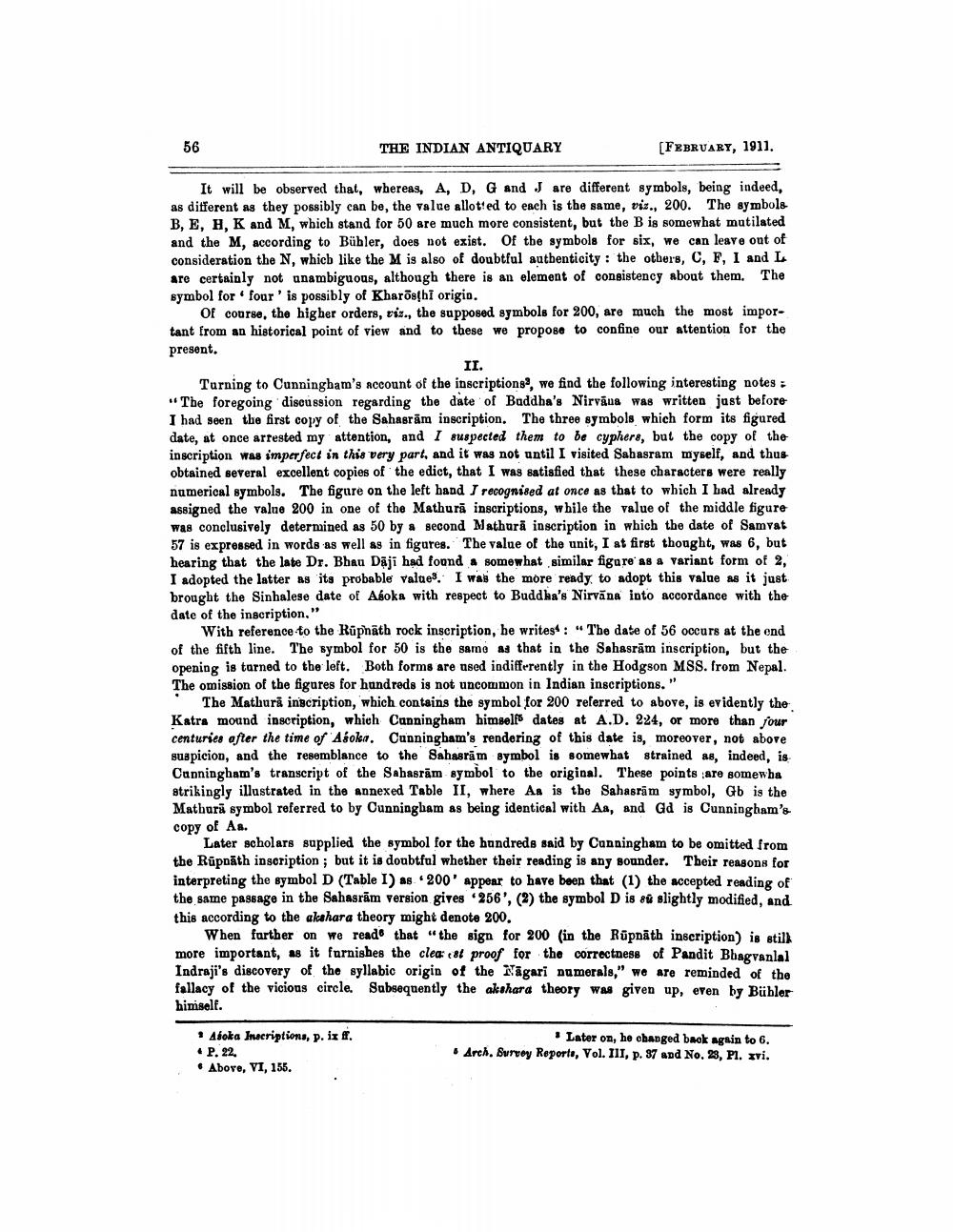________________
56
[FEBRUARY, 1911.
It will be observed that, whereas, A, D, G and J are different symbols, being indeed, as different as they possibly can be, the value allotted to each is the same, viz., 200. The symbols B, E, H, K and M, which stand for 50 are much more consistent, but the B is somewhat mutilated and the M, according to Bühler, does not exist. Of the symbols for six, we can leave out of consideration the N, which like the M is also of doubtful authenticity: the others, C, F, I and L are certainly not unambiguous, although there is an element of consistency about them. The symbol for four' is possibly of Kharōsthi origin.
Of course, the higher orders, viz., the supposed symbols for 200, are much the most important from an historical point of view and to these we propose to confine our attention for the present.
THE INDIAN ANTIQUARY
II.
Turning to Cunningham's account of the inscriptions, we find the following interesting notes: "The foregoing discussion regarding the date of Buddha's Nirvana was written just before I had seen the first copy of the Sahasram inscription. The three symbols which form its figured date, at once arrested my attention, and I suspected them to be cyphers, but the copy of the inscription was imperfect in this very part, and it was not until I visited Sahasram myself, and thus obtained several excellent copies of the edict, that I was satisfied that these characters were really numerical symbols. The figure on the left hand I recognised at once as that to which I had already assigned the value 200 in one of the Mathura inscriptions, while the value of the middle figure was conclusively determined as 50 by a second Mathura inscription in which the date of Samvat 57 is expressed in words as well as in figures. The value of the unit, I at first thought, was 6, but hearing that the late Dr. Bhau Daji had found a somewhat similar figure as a variant form of 2, I adopted the latter as its probable values. I was the more ready to adopt this value as it just brought the Sinhalese date of Asoka with respect to Buddha's Nirvana into accordance with the date of the inscription."
With reference to the Rupnath rock inscription, he writes: "The date of 56 occurs at the end of the fifth line. The symbol for 50 is the same as that in the Sahasram inscription, but the opening is turned to the left. Both forms are used indifferently in the Hodgson MSS. from Nepal. The omission of the figures for hundreds is not uncommon in Indian inscriptions. "
The Mathura inscription, which contains the symbol for 200 referred to above, is evidently the Katra mound inscription, which Cunningham himself dates at A.D. 224, or more than jour centuries after the time of Asoka. Cunningham's rendering of this date is, moreover, not above suspicion, and the resemblance to the Sahasram symbol is somewhat strained as, indeed, is Cunningham's transcript of the Sahasram symbol to the original. These points are somewha strikingly illustrated in the annexed Table II, where Aa is the Sahasram symbol, Gb is the Mathura symbol referred to by Cunningham as being identical with Aa, and Gd is Cunningham'scopy of Aa.
Later scholars supplied the symbol for the hundreds said by Cunningham to be omitted from the Rupnath inscription; but it is doubtful whether their reading is any sounder. Their reasons for interpreting the symbol D (Table I) as 200' appear to have been that (1) the accepted reading of the same passage in the Sahasram version gives 256', (2) the symbol D is su slightly modified, and this according to the akshara theory might denote 200.
When further on we reade that "the sign for 200 (in the Rupnath inscription) is stilk more important, as it furnishes the cleast proof for the correctness of Pandit Bhagvanlal Indraji's discovery of the syllabic origin of the Nagari numerals," we are reminded of the fallacy of the vicious circle. Subsequently the akshara theory was given up, even by Bühler himself.
* Asoka Inscriptions, p. ix ff.
4 P. 22.
Above, VI, 155.
Later on, he changed back again to 6. Arch. Survey Reports, Vol. III, p. 37 and No. 23, Pl. xvi.




